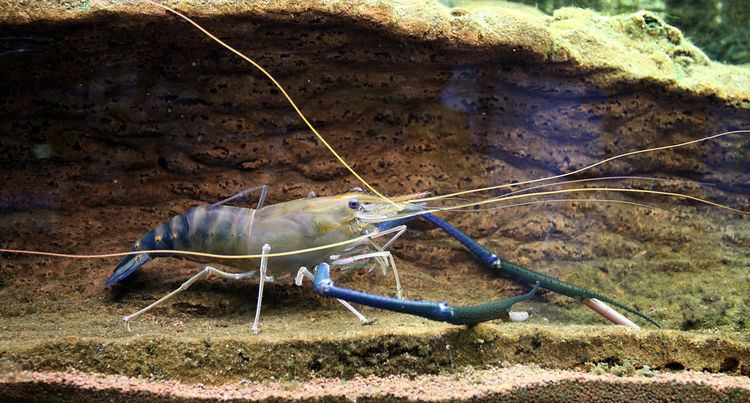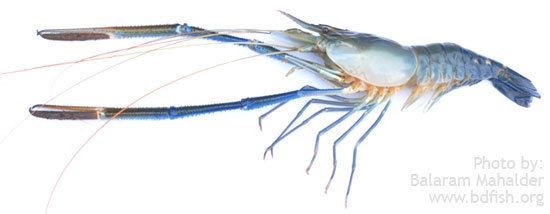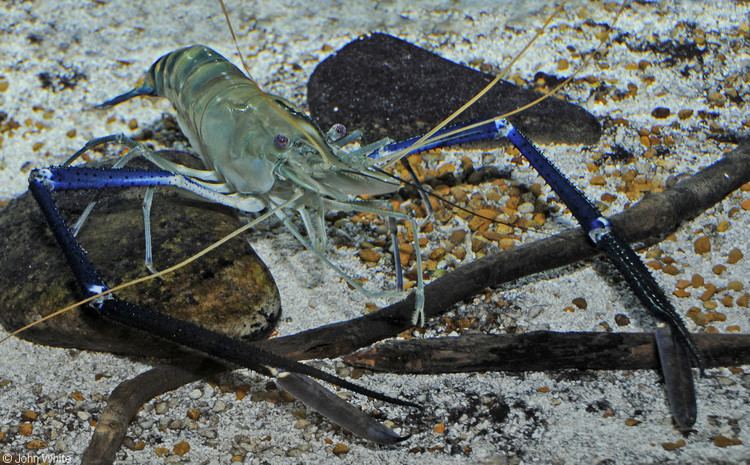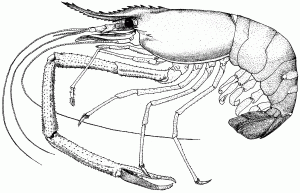Rank Species Higher classification Macrobrachium | Subphylum Crustacea Scientific name Macrobrachium rosenbergii | |
 | ||
Similar Caridean Shrimp, Macrobrachium, Giant tiger prawn, Whiteleg shrimp, Penaeus | ||
Macrobrachium rosenbergii, also known as the giant river prawn or giant freshwater prawn, is a commercially important species of palaemonid freshwater prawn. It is found throughout the tropical and subtropical areas of the Indo-Pacific region, from India to Southeast Asia and Northern Australia. The giant river prawn has also been introduced to parts of Africa, China, Japan, New Zealand, the Americas and the Caribbean. It is one of the biggest freshwater prawns in the world and is widely cultivated in several countries for food. While M. rosenbergii is considered a freshwater species, the larval stage of the animal depends on brackish water. Once the individual shrimp has grown beyond the planktonic stage and becomes a juvenile, it will live entirely in freshwater.
Contents

It is also known as the Malaysian prawn, freshwater scampi (India), or cherabin (Australia). Locally, it is known as bara chingri in Bangladesh, udang galah in Indonesia and Malaysia, uwang or ulang in the Philippines, and koong yai in Thailand.

Description

M. rosenbergii can grow to a length over 30 cm (12 in). They are predominantly brownish in color but can vary. Smaller individuals may be greenish in color and display faint vertical stripes. The rostrum is very prominent and contains 11 to 14 dorsal teeth and 8 to 11 ventral teeth. The first pair of walking legs (pereiopods) are elongated and very thin, ending in delicate claws (chelipeds) which are used as feeding appendages. The second pair of walking legs are much larger and powerful, especially in males. The movable claws of the second pair of walking legs are distinctively covered in dense bristles (setae) that give it a velvety appearance. The color of the claws in males vary according to their social dominance.

Females can be distinguished from males by their wider abdomens and smaller second pereiopods. The genital openings are found on the body segments containing the fifth pereiopods and the third pereiopods in males and females, respectively.
Morphotypes

Three different morphotypes of males exist. The first stage is called "small male" (SM); this smallest stage has short, nearly translucent claws. If conditions allow, small males grow and metamorphose into "orange claws" (OC), which have large orange claws on their second chelipeds, which may have a length of 0.8 to 1.4 times their body size. OC males later may transform into the third and final stage, the "blue claw" (BC) males. These have blue claws, and their second chelipeds may become twice as long as their bodies.
Males of M. rosenbergii have a strict hierarchy: the territorial BC males dominate the OCs, which in turn dominate the SMs. The presence of BC males inhibits the growth of SMs and delays the metamorphosis of OCs into BCs; an OC will keep growing until it is larger than the largest BC male in its neighbourhood before transforming. All three male stages are sexually active, and females that have undergone their premating moult will co-operate with any male to reproduce. BC males protect the female until their shells have hardened; OCs and SMs show no such behaviour.
Lifecycle

In mating, the male deposits spermatophores on the underside of the female's thorax, between the walking legs. The female then extrudes eggs, which pass through the spermatophores. The female carries the fertilised eggs with her until they hatch; the time may vary, but is generally less than three weeks. Females lay 10,000–50,000 eggs up to five times per year.
From these eggs hatch zoeae, the first larval stage of crustaceans. They go through several larval stages before metamorphosing into postlarvae, at which stage they are 0.28–0.39 in (7.1–9.9 mm) long and resemble adults. This metamorphosis usually takes place about 32 to 35 days after hatching. These postlarvae then migrate back into fresh water.
